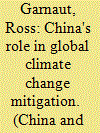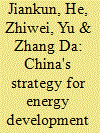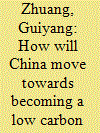|
|
|
Sort Order |
|
|
|
Items / Page
|
|
|
|
|
|
|
| Srl | Item |
| 1 |
ID:
134359


|
|
|
|
|
| Summary/Abstract |
China contributed a majority of the growth in global greenhouse gas emissions in the first 11 years of this century. The trajectory of emissions has changed radically since then, as China has implemented its Cancun 2010 commitment to reduce the 2005 emissions intensity of economic activity by 40–45 percent by 2020. The change in trajectory has been reinforced by China's new model of economic growth, with its greater emphasis on equity in income distribution, consumption and services. The large-scale deployment of low emissions technology in China is lowering the cost of transition to a low carbon economy all over the world. China's new emissions trajectory improves the opportunity for the international community to meet the 2°C climate target. It is essential that the changes in China are brought to account in shaping global mitigation ambition.
|
|
|
|
|
|
|
|
|
|
|
|
|
|
|
|
| 2 |
ID:
116907


|
|
|
|
|
| Publication |
2012.
|
| Summary/Abstract |
In recent years, China has made great efforts in energy saving and carbon emission reduction by pushing forward domestic sustainable development along with global climate change mitigation. The efforts have paid off with a dramatic decrease in carbon intensity. Nevertheless, China is still confronted with tough challenges in emission control due to the fast pace of industrialization, large total historical emission and high growth rate of emissions. Therefore, China should give priority to energy saving by improving energy efficiency and sectoral structure adjustment and upgrade, and develop sustainable and renewable energy to optimize energy mix and its carbon content. China should continue to regard significant reduction of energy intensity and carbon intensity as the main objective in the near future, strive to achieve peak emissions around 2030, and realize a relatively sharp emissions reduction by 2050 in order to address climate change to meet the goal of making the warming less than 2°. During the 12th Five Year Plan (FYP), China will further strengthen measures to control the amount of energy consumption, establish a statistics, accounting and evaluation system of carbon emissions, and promote a market-based carbon emissions trading mechanism to facilitate the low-carbon transformation of China's economy.
|
|
|
|
|
|
|
|
|
|
|
|
|
|
|
|
| 3 |
ID:
104809


|
|
|
| 4 |
ID:
117345


|
|
|
|
|
| Publication |
2013.
|
| Summary/Abstract |
In this paper, through the analysis of the great challenges faced by China's energy industry in the development of low carbon economy, it is advisable that China increase the proportion of natural gas (NG) in primary energy as the main strategy of energy conservation and CO2 reduction in the advancement of industrialization and urbanization. In the near future, NG will become one of the major energy suppliers for new towns and industrial parks, and work for electric peak shaving when used in distributed energy system/combined cold, heat and power (DES/CCHP). However, as an efficient approach to improve the energy utilization efficiency, DES/CCHP cannot only increase the current energy efficiency from 33% to 50.3% (the world's average), but also reduce the cost of terminal supplies of power, cold, steam and hot water. It will become one of the most important means to control CO2 emissions in the next 20 years, and is essential to China's low carbon industrialization and urbanization.
|
|
|
|
|
|
|
|
|
|
|
|
|
|
|
|
| 5 |
ID:
168319


|
|
|
|
|
| Summary/Abstract |
Within a low-carbon economy networks, governments and enterprises inevitably experience some level of distrust because of the complexity and uncertainty of policies. This study employs a questionnaire survey in China and finds a high level of distrust between government employees and enterprise managers when low carbon policies are enacted. However, the survey results also indicate a low frequency of communication on low carbon policy and that government employees and enterprise managers frame each other negatively. Furthermore, according to the result of a linear structural relations model, the frequency of communication and the ways in which government employees and enterprise managers frame each other are negatively correlated with the level of distrust. Therefore, an open policy process, co-working, and information sharing could all be effective ways to decrease the level of distrust. Moreover, specific low-carbon policies need to be established especially specific low-carbon standards for products, so as to reduce enterprises' distrust in low carbon policies.
|
|
|
|
|
|
|
|
|
|
|
|
|
|
|
|
| 6 |
ID:
150400


|
|
|
|
|
| Summary/Abstract |
In support of its ambitious target to reduce CO2 emissions the Scottish Government is aiming to have the equivalent of 100% of Scottish electricity consumption generated from renewable sources by 2020. This is, at least in part, motivated by an expectation of subsequent employment growth in low carbon and renewable energy technologies; however there is no official data source to track employment in these areas. This has led to a variety of definitions, methodologies and alternative estimates being produced. Building on a recent study (Bishop and Brand, 2013) we develop a “hybrid” approach which combines the detail of “bottom-up” surveys with “top-down” trend data to produce estimates on employment in Low Carbon Environmental Goods and Services (LCEGS). We demonstrate this methodology to produce estimates for such employment in Scotland between 2004 and 2012. Our approach shows how survey and official sources can combine to produce a more timely measure of employment in LCEGS activities, assisting policymakers in tracking, consistently, developments. Applying our approach, we find that over this period employment in LCEGS in Scotland grew, but that this was more volatile than aggregate employment, and in particular that employment in this sector was particularly badly hit during the great recession.
|
|
|
|
|
|
|
|
|
|
|
|
|
|
|
|
| 7 |
ID:
081899


|
|
|
|
|
| Publication |
2008.
|
| Summary/Abstract |
China is facing increasing pressure from the international community to curb its greenhouse emissions. The next 15-20 years are important for China's social and economic development, but this is also a key period for controlling global greenhouse gas emissions. In considering the development path of China's economy, policy-makers are confronted by the issue of global climate change. Reducing carbon emissions is now a worldwide task. For China, opportunities and challenges coexist. Post-Kyoto climate regime must provide incentives for China's transition to becoming a low carbon economy based on the principle of common but differentiated responsibilities
|
|
|
|
|
|
|
|
|
|
|
|
|
|
|
|
| 8 |
ID:
109685


|
|
|
|
|
| Publication |
2011.
|
| Summary/Abstract |
Guiding a transition to low carbon electricity requires a good understanding of the substitution of old by new technologies in the electricity industry. With the aim of explaining historical change from coal to gas in the British electricity industry, we develop a formal model of technological change, where energy technologies diffuse through the construction of new power plants. We considered two model versions: with rational and boundedly rational investors. In each model version, we look at the causal relations between price and output setting mechanisms, fuel and labour use, and investment decisions for different institutional arrangements. We quantify model parameters on data for the United Kingdom. We find that the version of the model with rational investors is capable of replicating well core features of UK electricity history. This includes a rapid diffusion of gas in electricity production, the evolution of the average size of newly installed plants, and a high percentage of electricity sales covered by (forward) contracts-for-difference. In this model setting, nuclear and renewable energies have no chance to diffuse on the market. In the version of the model with boundedly rational investors, nuclear power typically dominates electricity production. We discuss implications of our modelling results for making a transition to low carbon electricity in the future.
|
|
|
|
|
|
|
|
|
|
|
|
|
|
|
|
| 9 |
ID:
126599


|
|
|
|
|
| Publication |
2013.
|
| Summary/Abstract |
For a developing country such as China, it is important to select a fair pattern that is suitable for China's national conditions for low carbon-economy development, as it has a direct impact on the success (or not) of low carbon-economy development. This research shows that, under the real-life conditions of China's development, different development patterns should be practised depending on specific socioeconomic conditions. Among them, one of the most critical issues is how to make full use of natural forces, and thus the nature-oriented development pattern should be practised in full. At the same time, China should still practise either the single regional differential or the multi-regional linkage development pattern under different conditions and either the imposed or the induced development pattern at the different stages of development.
|
|
|
|
|
|
|
|
|
|
|
|
|
|
|
|
| 10 |
ID:
116688


|
|
|
|
|
| Publication |
2012.
|
| Summary/Abstract |
This introduction to the special issue on past and prospective energy transitions presents some insights from research into past energy transitions of relevance for a possible transition to a low carbon economy. It also provides a synthesis of insights generated during a workshop attended by many of the leading researchers on this topic at Cardiff University in April 2011. The final section introduces the articles in the special issue. It is hoped that the workshop and this issue will help to move forwards the integration of the exciting research on past energy transitions in ways that will also offer valuable insights into the challenges of prospective low carbon transitions.
|
|
|
|
|
|
|
|
|
|
|
|
|
|
|
|
| 11 |
ID:
185723


|
|
|
|
|
| Summary/Abstract |
Hydrogen is attracting increasing attention and investment in the low carbon energy transition. However, it is expected that any transition to hydrogen at a meaningful scale or rate, will be dependent on the industry obtaining a social licence, underpinned by public acceptance. This study analyses responses from a public survey that asked 1,824 residents of South Australia and Victoria (Australia) to indicate how important six characteristics of a hydrogen industry would be in their decision to support the development of such an industry, namely: (1) safety; (2) climate change mitigation; (3) affordability; (4) reliability; (5) accessibility; and (6) job creation. Overall, safety was rated as the most important characteristic, followed by climate change mitigation and affordability. Fractional multinomial logit model estimates found socio-demographic (e.g. age, location) and attitudinal characteristics (e.g. concern about climate change, hydrogen knowledge) statistically significantly influenced individuals’ importance ratings of hydrogen industry characteristics. This research indicates the trade-offs that individuals may—or may not be—willing to make in the transition to hydrogen energy. Such information can be used to align policy and investment decisions with public expectations for the further development of the hydrogen industry in Australia.
|
|
|
|
|
|
|
|
|
|
|
|
|
|
|
|
| 12 |
ID:
099242


|
|
|
|
|
| Publication |
2010.
|
| Summary/Abstract |
This paper reviews past energy transitions by sector and service to identify features that may be useful for future transitions. Although often considered a single event, the transition from traditional energy sources to fossil fuels involved numerous services and sectors at different times between 1500 and 1920. The main economic drivers identified for energy transitions were the opportunities to produce cheaper or better energy services. The existence of a niche market willing to pay more for these characteristics enabled new energy sources and technologies to be refined gradually until they could compete with the incumbent energy source. Nevertheless, this implied that, on average, the whole innovation chain took more than 100 years and the diffusion phase nearly 50 years. In the same way, low-carbon energy sources and technologies offer an additional characteristic (i.e. low carbon impact), which might be able to develop gradually in a niche market until they can compete with fossil fuels. However, because of consumers' tendency to free-ride, a successful transition will need governments to provide protection of this niche market-possibly for decades. Based on past experiences, a complete transition to a low carbon economy is likely to be very slow.
|
|
|
|
|
|
|
|
|
|
|
|
|
|
|
|
|
|
|
|
|